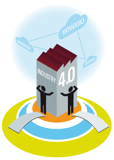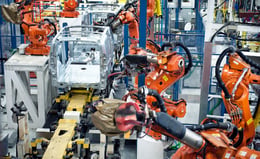Transport Logistics in the Era of Industry 4.0
Brian Hoey - May 24, 2018

The rise of Industry 4.0 is already impacting the way that supply chain managers do business. As it continues to promote digitization and interoperability across all touchpoints on the global value chain, it will no doubt bring about significant changes across a variety of different supply stream operations. No doubt one of the most significantly impacted processes will be transport logistics, which might lead one to wonder, “what will transport logistics look like in the Industry 4.0 era?”
Information Revolution
One of the most significant effects of the Industry 4.0 revolution will be a marked increase in data quality and availability. A certain high degree of intra-operational visibility is already a necessity for businesses trying to adopt more sophisticated IT solutions, but the technology that makes smart factories possible also helps bring about end-to-end (E2E) visibility within businesses, connecting disparate points on the value stream into a more cohesive architecture. This boost in data quality and transparency has significant ramifications for transportation planning. Specifically, it can enable planners to:
- Create more accurate shipping and demand forecasts
- Develop more flexible shipping and routing options based on real-time traffic, weather, and restriction data
- Respond in a quick and agile manner to potential disruptions or bottlenecks by utilizing up-to-the-minute information about freight capacity and hub/warehouse usage.
Where, historically, transportation planning has been hampered by information silos and Shadow IT, lacking the necessary information to make optimal decisions, Industry 4.0 systems can help to prevent the sort of rigid, inflexible, and unadaptable plans that such conditions inevitably result in. More than that, shared, cohesive IT solutions (as opposed to Shadow IT, which resists integration into larger operational infrastructures) can bolster communication between transport planners and other key stakeholders, increasing the likelihood that transport will be more fully integrated with business goals.
Increased Connectivity
Though the increase in inter- and intra-operational connectivity will be a major force for reducing breakdowns and silos going forward, it’s not the only way in which increased connectivity is changing the nature of transport logistics. The integration of Internet-of-Things (IoT) devices and other connected technologies into the supply chain also stand to impact the way that products are moved from the factory floor to their eventual destination.
Let’s say, for instance, that you’re trying to administer a transport network that includes a number of hubs and vehicles. When a truck breaks down en route to a delivery, you’re tasked with the challenge of mitigating the damage and restoring on-time deliveries. Traditionally, this situation would have almost certainly resulted in a thorny, ongoing bottleneck, but in the era of Industry 4.0, you can track your entire freight network in real time and create and implement new routes and shipping plans in an instant. Perhaps you find that one of your trucks is operating near the breakdown with a less-than-full truckload and can accommodate some of the other vehicle’s freight, thereby preserving a meaningful amount of value. Or, maybe you’re able to determine that your supplier has the capacity to provide you with replacement product with little or no lead time, meaning that if you can arrange for sufficient truck capacity you can resume an almost normal delivery schedule. In each of these instances, an increasingly connected value chain can help you to adapt to the unexpected in a flexible, agile, and ultimately value-additive way.
The Future is Autonomous
In the above examples, you as the planner had to process and understand a large amount of mission-critical data. While the availability of this data is one of the crowning achievements of the fourth industrial revolution so far, the scenario above also represents an instance where the new technologies under discussion still have room to grow. Indeed, many are now conceiving of a future in which planners don’t need to respond manually to disruptions of those variety at all, leaving complex software to communicate with machines and real-time, inter-operational data in order to find the optimal response to the event. While this may sound farfetched, it is precisely the Industry 4.0 advances in machine-to-machine communication that are already making this possible for some organizations.
Indeed, as Industry 4.0 continues to promote autonomous decision making within digitized and robotic supply chain processes, transport logistics will see more and more tasks taken over by machine learning and advanced analytics software. For businesses that have the necessary infrastructure to implement these technologies, increased automation has the potential to save human planners time and effort that would otherwise be spent manually adjusting shipping routes and capacity plans. Looking even further ahead, the use of self-driving cars will further improve data and machine communication within the supply chain, eventually resulting in advances in transportation planning that had barely been considered even a few decades ago.
If you want to learn more get your Guide to Industry 4.0:
LATEST POSTS
- Understand Why Production Planning Needs Specialized Solutions
- Understand Circular Economy in The Manufacturing Industry
- How Can Industry 4.0 IT Integration Be Achieved Smoothly?
- The Significance of Order Sequencing in Discrete Manufacturing
- How to improve your Supply Chain Management: The Power of Control Towers



